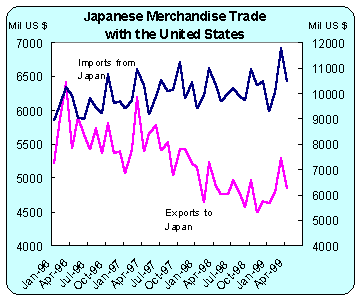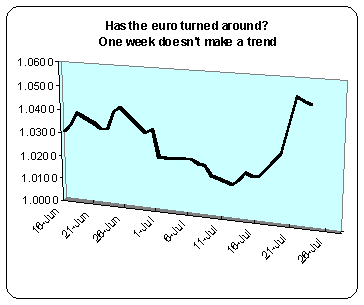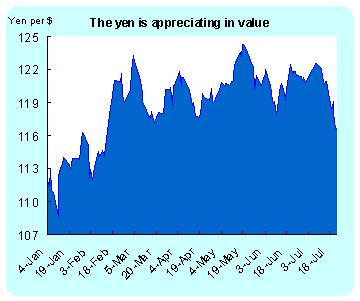|
International Perspective July 26, 1999
Anne D. Picker,
International Economist
Foreign Trade
Two of the United States' most important trading partners - Canada and Japan - released their merchandise trade data this week.
Japan's surplus falls but...
The Japanese trade surplus fell in June for the third straight month. However, the politically sensitive surplus with the United States rose once again. The overall trade surplus is falling because of lower exports from Japan; however imports also remain weak - a sign of the struggling economy. Although the Japanese economy is showing signs that it has finally reached bottom, demand has not yet translated into increased imports.
The good news was that Japan's exports to the rest of Asia rose for the first time in 18 months, which suggests a recovery in Asian economic activity. This is very important to the Japanese economy because Asia is the primary destination for exports. Rising Asian demand also is a positive for the U.S. trade deficit. With demand picking up, the United States will no longer be the only market to take in imports.
The Japanese trade report is very sensitive because of the important role that Japan plays in the world economy. The huge merchandise trade deficit with the United States raises political ire here because of limited access to Japanese markets for American goods. The graph below is based on the U.S. merchandise trade report also released this week for easier comparisons.

Canada's trade surplus continues but...
While trade with Japan is politically sensitive, trade with Canada is not. The reason simply is that there is a free flow of goods across the border both ways. The Canadian trade surplus rose modestly in May with exports continuing to perform well. Canada also has a surplus in bilateral trade with the United States, which is expected to continue as long as the United States economy continues to outperform Canada.
Since the inception of the North American Free Trade Agreement (Nafta) between the United States, Canada, and Mexico, trade between the three countries has grown dramatically. In May, eighty-five percent of Canadian exports went to the United States. However, a large proportion of these exports was intracompany. For example, the automobile industry exports auto components to Canada for assembly. The finished products are returned to this country for sale. Historically, there is less friction between countries when this occurs. Typically frictions occur in industries where there is no intracompany trade. Canadian trade also has benefited because the Canadian dollar has lost about 7.5 percent of its value against the U.S. dollar since the beginning of 1995 making Canadian products less expensive in U.S. markets. The graph below, again from the U.S. trade data, shows the vigorous growth in both imports and exports with Canada.

Why is trade so important to the United States?
After the United States was forced into becoming the world's consumer of first and last resort, the U.S. trade deficit swelled dramatically. Because of Asia's economic problems and meager growth elsewhere, the world has had excess productive capacity. Commodity prices, the basic inputs to production, continue to be cheap, and U.S. growth has benefited by relying on the anti-inflationary effects of these cheap imports. The world economy finally appears to be turning around. Other economies will be competing for the commodities and goods that have been ours for the taking, and if demand is strong enough, it could put pressure on prices.
Financial Markets
World Stock Exchanges
Stocks closed lower this week on the world's major stock markets. Market players were nervous, first about what U.S. Federal Reserve chairman Alan Greenspan might say and then about what he did say. (See this week's Simply Economics for a full discussion of Mr. Greenspan's Humphrey Hawkins testimony.) This was also a big week for second quarter earnings reports. The table below gives last week's changes in the world's key indexes.
| Selected World Stock Market Indexes |
| Index | 23-Jul | 1999
High | 1999
Low | Week %
Change |
|---|
| Asia |
| Australia | All Ordinaries | 3070.20 | 3145.20 | 2804.80 | 0.52 |
| Japan | Nikkei 225 | 17534.44 | 18357.90 | 13232.70 | -3.91 |
| Hong Kong | Hang Seng | 13093.70 | 14506.74 | 9076.33 | -3.33 |
| S. Korea | Korea Composite | 904.96 | 1027.93 | 498.42 | -11.35 |
| Europe |
| Britain | FTSE 100 | 6207.40 | 6420.60 | 5770.20 | -5.42 |
| France | CAC | 4440.45 | 4697.80 | 3958.70 | -4.65 |
| Germany | XETRA DAX | 5310.63 | 5652.00 | 4668.50 | -5.50 |
| North America |
| United States | Dow | 10910.96 | 11209.80 | 9120.70 | -2.67 |
| Canada | TSE Composite 300 | 7069.50 | 7292.70 | 6180.30 | -2.97 |
| Mexico | Bolsa | 5613.19 | 7292.70 | 6180.30 | -4.64 |
The main stock indexes were under pressure suffering the repercussions of Mr. Greenspan's speech. The markets interpreted his remarks as an indication that the Federal Reserve would sanction another increase in U.S. interest rates if there were further evidence of inflationary pressures building in the U.S. economy. Another reason for the poor showing was that markets tend to be more volatile in the dog days of summer because liquidity isn't there.
Currencies
The Euro
The euro staged a dramatic turnaround this week, after a stronger than expected German business confidence survey (Ifo Index). This followed on the heels of a strong upturn in business sentiment in France as well. The Ifo suggested an improvement in the industrial sector over recent months. German orders posted a big rise as well. These data, combined with strengthening exports finally is providing evidence that the European economies are on an upturn. France and Germany are the largest economies and main drivers of growth in the euro block. However, given tighter fiscal policy in Germany along with continuing structural rigidities in the labor force, stronger growth is not a certainty.

The graph above shows that the euro was rapidly approaching parity with the dollar - i.e. a one to one relationship - before last week's surge. (See last week's International Perspective and January's Focal Point for more information on the euro.)
The Yen
The yen is also rising. Despite several efforts of the Japanese monetary authorities in the foreign exchange markets to push the value of the yen down (that is, more yen per dollar) they appear to have given up for now. The finance minister warned that Japan would take action again in the future to push down the value of the yen, because the rising value of the yen could harm the Japanese economy.

At the close on Friday, the foreign exchange rate for the yen was 116.55 to the dollar. Just last week there were over 120 yen to the dollar. Fewer yen per dollar means that the yen is rising in value.
Japanese government officials admitted this week that the first quarter's strong growth is unlikely to be repeated in the second quarter. Government forecasters are projecting negative growth for the second quarter, which should take some pressure off the yen. One of the factors that supported the yen's increase in value has been foreign inflows to buy Japanese stocks. However, with slow or no growth, this pressure should ease.
Why investors should care...
With more positive economic outlooks for Europe and Asia, overseas markets are coming to life again. Investors should find many opportunities to get in on the ground floor to take advantage of these expanding economies, especially in Europe.
Looking Ahead
Below is a list of selected indicator releases for this week.
|
Europe | | |
| July 26 | Germany | PPI ((June) |
| July 26 | France | CPI (June) |
| July 27 | France | Housing Starts (June) |
| July 27 | United King | CBI Industrial Trends Survey |
| July 29 | EMU | Trade balance (Final April) |
| EMU | Gross Domestic Product (Final first quarter) |
| EMU | European Central Bank Governing Council Meeting |
| United King | Gross Domestic Product (Final first quarter) |
Asia | | |
| July 26 | Japan | Consumer confidence (Second quarter) |
| July 27 | Japan | Retail Sales (June) |
| July 29 | Japan | Industrial Production (June) |
North America | | |
| July 30 | Canada | GDP at Factor Cost (May) |
For U.S. data releases, see this week's Simply Economics.
|





